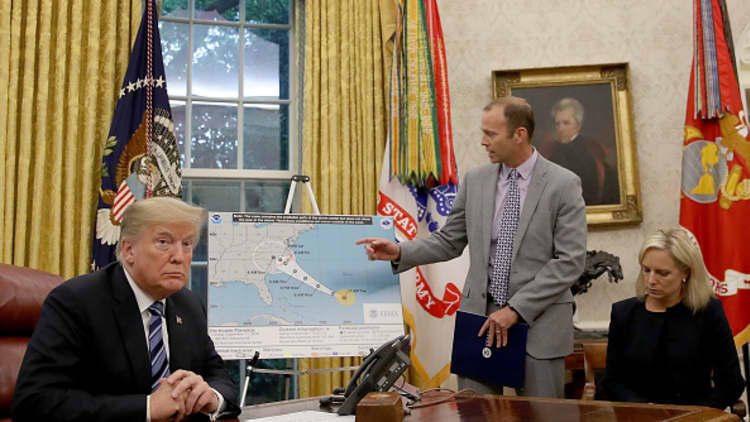
Hurricane Florence is bearing down on the midsection of the East Coast, expected to make landfall later this week with the most strength since Hurricane Hazel in 1954 – a storm which destroyed about 15,000 buildings as it maintained hurricane level winds as far inland as Raleigh, North Carolina.
The hurricane — on track to become the first Category 4 storm to directly hit North Carolina in 60 years — is expected to make landfall by early Friday. The National Hurricane Center (NHC) warned there could be a storm surge as high as 13 feet, bringing with it catastrophic floods if the storm stalls inland.
"This storm is a monster," North Carolina Governor Roy Cooper said. "Even if you've ridden out storms before, this one is different. Don't bet your life on riding out a monster."
More than 1½ million people have been ordered to evacuate their homes along the coast as government officials in North Carolina, South Carolina, Virginia, Maryland and Washington, D.C. declared states of emergency. Florence maintained Category 4 strength about 785 miles east south east of Cape Fear, North Carolina as of 5 p.m. ET Tuesday, the NHC said. The storm has maximum sustained winds of 140 miles per hour, strengthened from earlier in the day, and is already 500 miles wide.
"Further strengthening is forecast tonight and Wednesday. While some weakening is expected on Thursday, Florence is forecast to be an extremely dangerous major hurricane through landfall," the National Hurricane Center said. The Center also upgraded its previous storm surge watch and hurricane watch to warnings, affecting a majority of the North Carolina and South Carolina coasts.
The Center expects Florence to produce between 15 to 25 inches of total rainfall across portions of North Carolina, Virginia and South Carolina until Saturday, with up to 35 inches closer to the center of the storm. Florence may also create "life-threatening flash flooding" and "damaging hurricane-force winds" the Center said.
Hurricane Hazel in 1954 registered winds of 150 miles per hour when it made landfall on the North Carolina coast. Jay Barnes, a hurricane historian and author, told AP that Hazel was "a benchmark storm in North Carolina's history." With evacuations already underway across the region, Barnes says the damage Florence may cause could be notably greater than Hazel's impact.
"Today, we have thousands and thousands of permanent residents on our barrier beaches," Barnes told AP. "It's a totally different scenario with regard to human impact."
Several companies are already taking steps to prepare for the storm. BMW is working to load vehicles at its Spartanburg, South Carolina plant on ships headed out to sea to avoid Florence's path. Boeing will suspend operations at its Charleston, South Carolina location with 6,700 employees "so our employees can properly evacuate," the company said.
Lowe's has already shipped 800 truckloads of products to about 100 stores that will be affected by the hurricane, VP of Store Operations Jennifer Thayer told CNBC. The company will also close its coastal stores at 6 p.m. ET on Tuesday to allow employees to evacuate.
JetBlue, Delta and United Airlines have all capped fares and waived change fees ahead of the storm hitting land.
J.P. Morgan estimated Monday that Hurricane Florence could cause the insurance industry to lose between $8 billion and $20 billion, depending on the timing and intensity of the storm when it makes landfall.
"This would make Hurricane Florence one of the top 10 most costly hurricanes to hit the U.S.," J.P. Morgan analyst Sarah DeWitt said in a note.
The National Hurricane Center has issued a storm surge watch from Edisto Beach, South Carolina to the border of North Carolina and Virginia. Coastal areas may see waters surge by as much as 8 feet or more above ground if Florence's peak surge coincides with a high tide.
"The deepest water will occur along the immediate coast in areas of onshore winds, where the surge will be accompanied by large and destructive waves," the Center said.
The Port of Virginia expects to remove ships overnight on Tuesday and plans to be completely empty by 6 a.m. ET Wednesday, a spokesperson told CNBC. The Port of Savannah in Georgia will remain open until further notice.
Footage of #HurricaneFlorence2018 from today's @53rdWRS @AirForceReserve Hurricane Hunter mission.
– AP and Reuters contributed to this report.
WATCH: Florence larger than we've seen in decades, says Trump




